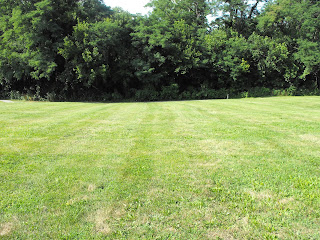Blue Springs Lake Campground, Blue Springs, MO, Site 29. We did a lot of riding today to reach this point. This campground is one of the actual campsites where wagons would wait until enough wagons had gathered to form a wagon train. Since we have read several books about the Oregon Trail it was very interesting to us to think that pioneers had actually been in this spot waiting for other family members or friends to arrive.
Jim Bridger was one of the earliest mountain men who explored the Western United States.
In the winter of 1824-1825, Bridger gained fame as the first white man to see the Great Salt Lake. On the Oregon Trail he established Fort Bridger on the west bank of the Green River. In 1850 he discovered what would eventually be known as Bridger's Pass, looking for an alternate overland route to the South Pass he discovered in 1827. Bridger Pass would later be the chosen route for both the Union Pacific Railroad and Interstate 80.
Easy parking along the Gateway Arch
Beautiful Sunday Morning
Finally we reached Independence, MO, our "jumping off" place for the Oregon Trail! We visited the National Frontier Trails Center where we saw a great film West which told the early history of the trails--Santa Fe, Oregon, and Mormon.The volunteers at the Center were very helpful. They gave us a series of booklets published in 2005 and 2006 by the National Park Service of the US Dept. of the Interior called National Historic Trails: Auto Tour Route Interpretive Guide. The guides are written by the National Trails System which divide the Oregon Trail into sections, for example, Western Missouri-Northeast Kansas. The major highways and best roads do not always follow the Oregon Trail but the booklets do tell you the nearest town and county road. At times, we did travel on gravel roads and "corduroy" (very bumpy) roads to reach a marker. The Roadside Auto Tour signs mark the general routes of the Oregon, California, and Pony Express national historic trails.
Many pioneers thought this wagon was too difficult to travel in on the Trail.
Many pioneers chose this wagon as it is easier to navigate over mountains and across rivers.
Swales
Depot for Chicago and Alton Railroad
Telegraph desk at Depot
(Ron says he remembers someone working at a telegraph desk in his hometown.)
I learned that women from Europe were the first to bring rounded-top trunks to America because they did not want other baggage to be placed on top of their trunks.
It was getting late so we just drove by President Harry Truman's home as we wanted to get to the courthouse in Independence, MO, to begin our West trip.
President Harry Truman's Home
We are ready to "jump off" for our trip along the Oregon Trail. The marker is in front of the Courthouse in Independence, MO. Posters and announcements would be made that wagons would be gathering in front of the Courthouse on a certain date to form a wagon train. Hundreds of wagons and people would gather to begin their journey.













No comments:
Post a Comment